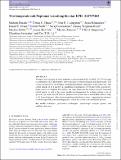Files in this item
Two temperate sub-Neptunes transiting the star EPIC 212737443
Item metadata
| dc.contributor.author | Herath, Mahesh | |
| dc.contributor.author | Hinse, Tobias C. | |
| dc.contributor.author | Livingston, John H. | |
| dc.contributor.author | Hernández, Jesús | |
| dc.contributor.author | Evans, Daniel F. | |
| dc.contributor.author | Wells, Robert | |
| dc.contributor.author | Gunesekera, Saraj | |
| dc.contributor.author | Tregloan-Reed, Jeremy | |
| dc.contributor.author | Rabus, Markus | |
| dc.contributor.author | Skottfelt, Jesper | |
| dc.contributor.author | Dominik, Martin | |
| dc.contributor.author | Jørgensen, Uffe G. | |
| dc.contributor.author | Jayaratne, Chandana | |
| dc.contributor.author | Lý, Cuc T. K. | |
| dc.date.accessioned | 2019-07-18T09:30:02Z | |
| dc.date.available | 2019-07-18T09:30:02Z | |
| dc.date.issued | 2019-09 | |
| dc.identifier | 259652439 | |
| dc.identifier | 1afc6100-4cf2-47dd-89b5-ffdde527298a | |
| dc.identifier | 85078461992 | |
| dc.identifier | 000482319700043 | |
| dc.identifier.citation | Herath , M , Hinse , T C , Livingston , J H , Hernández , J , Evans , D F , Wells , R , Gunesekera , S , Tregloan-Reed , J , Rabus , M , Skottfelt , J , Dominik , M , Jørgensen , U G , Jayaratne , C & Lý , C T K 2019 , ' Two temperate sub-Neptunes transiting the star EPIC 212737443 ' , Monthly Notices of the Royal Astronomical Society , vol. 488 , no. 1 , pp. 536–546 . https://doi.org/10.1093/mnras/stz1641 | en |
| dc.identifier.issn | 0035-8711 | |
| dc.identifier.other | BibCode: 2019MNRAS.tmp.1567H | |
| dc.identifier.other | ORCID: /0000-0002-3202-0343/work/75996709 | |
| dc.identifier.uri | https://hdl.handle.net/10023/18120 | |
| dc.description.abstract | We report the validation of a new planetary system around the K3 star EPIC 212737443 using a combination of K2 photometry, follow-up high-resolution imaging and spectroscopy. The system consists of two sub-Neptune sized transiting planets with radii of 2.6R⊕ and 2.7R⊕, with orbital periods of 13.6 and 65.5 d, equilibrium temperatures of 536 and 316 K, respectively. In the context of validated K2 systems, the outer planet has the longest precisely measured orbital period, as well as the lowest equilibrium temperature for a planet orbiting a star of spectral type earlier than M. The two planets in this system have a mutual Hill radius of ΔRH = 36, larger than most other known transiting multiplanet systems, suggesting the existence of another (possibly non-transiting) planet, or that the system is not maximally packed. | |
| dc.format.extent | 3411429 | |
| dc.language.iso | eng | |
| dc.relation.ispartof | Monthly Notices of the Royal Astronomical Society | en |
| dc.subject | Techniques: photometric | en |
| dc.subject | Techniques: spectroscopic | en |
| dc.subject | eclipses | en |
| dc.subject | Planets and satellites: detection | en |
| dc.subject | QB Astronomy | en |
| dc.subject | QC Physics | en |
| dc.subject | NDAS | en |
| dc.subject.lcc | QB | en |
| dc.subject.lcc | QC | en |
| dc.title | Two temperate sub-Neptunes transiting the star EPIC 212737443 | en |
| dc.type | Journal article | en |
| dc.contributor.institution | University of St Andrews. St Andrews Centre for Exoplanet Science | en |
| dc.contributor.institution | University of St Andrews. School of Physics and Astronomy | en |
| dc.identifier.doi | https://doi.org/10.1093/mnras/stz1641 | |
| dc.description.status | Peer reviewed | en |
| dc.identifier.url | http://adsabs.harvard.edu/abs/2019MNRAS.tmp.1567H | en |
| dc.identifier.url | https://academic.oup.com/mnras/article/488/1/536/5519234 | en |
This item appears in the following Collection(s)
Items in the St Andrews Research Repository are protected by copyright, with all rights reserved, unless otherwise indicated.

